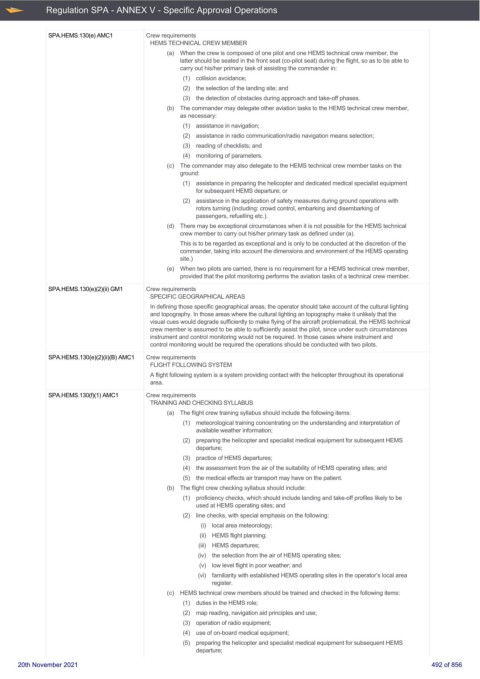Page 492 - UK Air Operations Regulations 201121
P. 492
~
~ Regulation SPA - ANNEX V - Specific Approval Operations Centrik
SPA.HEMS.130(e) AMC1 Crew requirements
HEMS TECHNICAL CREW MEMBER
(a) When the crew is composed of one pilot and one HEMS technical crew member, the
latter should be seated in the front seat (co-pilot seat) during the flight, so as to be able to
carry out his/her primary task of assisting the commander in:
(1) collision avoidance;
(2) the selection of the landing site; and
(3) the detection of obstacles during approach and take-off phases.
(b) The commander may delegate other aviation tasks to the HEMS technical crew member,
as necessary:
(1) assistance in navigation;
(2) assistance in radio communication/radio navigation means selection;
(3) reading of checklists; and
(4) monitoring of parameters.
(c) The commander may also delegate to the HEMS technical crew member tasks on the
ground:
(1) assistance in preparing the helicopter and dedicated medical specialist equipment
for subsequent HEMS departure; or
(2) assistance in the application of safety measures during ground operations with
rotors turning (including: crowd control, embarking and disembarking of
passengers, refuelling etc.).
(d) There may be exceptional circumstances when it is not possible for the HEMS technical
crew member to carry out his/her primary task as defined under (a).
This is to be regarded as exceptional and is only to be conducted at the discretion of the
commander, taking into account the dimensions and environment of the HEMS operating
site.)
(e) When two pilots are carried, there is no requirement for a HEMS technical crew member,
provided that the pilot monitoring performs the aviation tasks of a technical crew member.
SPA.HEMS.130(e)(2)(ii) GM1 Crew requirements
SPECIFIC GEOGRAPHICAL AREAS
In defining those specific geographical areas, the operator should take account of the cultural lighting
and topography. In those areas where the cultural lighting an topography make it unlikely that the
visual cues would degrade sufficiently to make flying of the aircraft problematical, the HEMS technical
crew member is assumed to be able to sufficiently assist the pilot, since under such circumstances
instrument and control monitoring would not be required. In those cases where instrument and
control monitoring would be required the operations should be conducted with two pilots.
SPA.HEMS.130(e)(2)(ii)(B) AMC1 Crew requirements
FLIGHT FOLLOWING SYSTEM
A flight following system is a system providing contact with the helicopter throughout its operational
area.
SPA.HEMS.130(f)(1) AMC1 Crew requirements
TRAINING AND CHECKING SYLLABUS
(a) The flight crew training syllabus should include the following items:
(1) meteorological training concentrating on the understanding and interpretation of
available weather information;
(2) preparing the helicopter and specialist medical equipment for subsequent HEMS
departure;
(3) practice of HEMS departures;
(4) the assessment from the air of the suitability of HEMS operating sites; and
(5) the medical effects air transport may have on the patient.
(b) The flight crew checking syllabus should include:
(1) proficiency checks, which should include landing and take-off profiles likely to be
used at HEMS operating sites; and
(2) line checks, with special emphasis on the following:
(i) local area meteorology;
(ii) HEMS flight planning;
(iii) HEMS departures;
(iv) the selection from the air of HEMS operating sites;
(v) low level flight in poor weather; and
(vi) familiarity with established HEMS operating sites in the operator’s local area
register.
(c) HEMS technical crew members should be trained and checked in the following items:
(1) duties in the HEMS role;
(2) map reading, navigation aid principles and use;
(3) operation of radio equipment;
(4) use of on-board medical equipment;
(5) preparing the helicopter and specialist medical equipment for subsequent HEMS
departure;
20th November 2021 492 of 856

